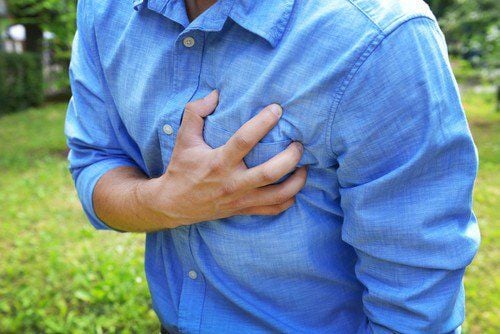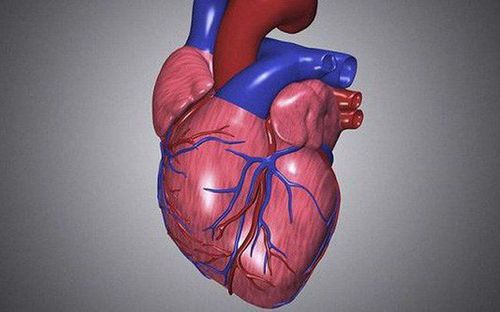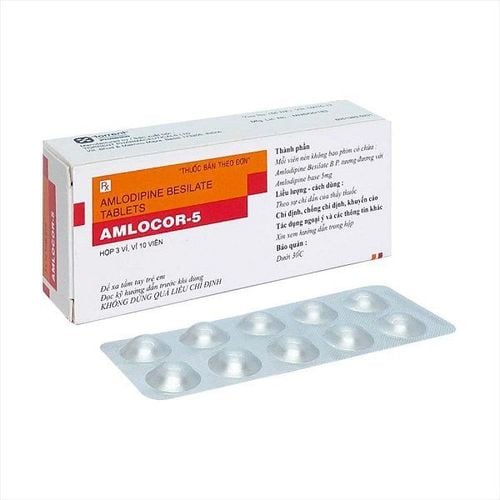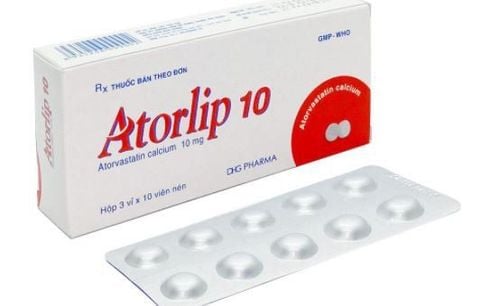This is an automatically translated article.
The article was professionally consulted by Dr. Tran Quoc Tuan - Emergency Medicine Doctor - Emergency Resuscitation Department - Vinmec Phu Quoc International General Hospital.Myocardial infarction is an emergency condition, the patient can die very quickly if not treated promptly. Up to 10% of heart attacks result in sudden death. This article will clarify the dangerous complications of a heart attack that we need to be very vigilant about.
1. What is a myocardial infarction?
Myocardial infarction is the most dangerous complication of coronary artery disease and also the leading cause of death in cardiovascular diseases.An infarction occurs when in the lumen of a coronary artery, the flow of blood carrying oxygen and nutrients to the heart muscle cells is suddenly completely blocked. When the heart muscle is no longer supplied with enough blood, it will die. This is an emergency condition, the patient can die very quickly if not treated promptly, the lucky cases that survive, the risk of heart failure in the future is also very high.
2. Signs to recognize a heart attack
Acute myocardial infarction is when a patient shows specific signs such as severe angina, pain that seems to be strangled behind the sternum, in front of the heart, then spreading to the left shoulder and left hand; pain in the end to the ring finger and little finger. Sudden episodes of pain, often lasting more than 20 minutes, that are not relieved by pain relievers. Feeling a lot of pain sometimes spreads to the neck, to the chin, then to the shoulders, hands, and even the back.However, a few cases of patients develop disease without seeing or feeling little pain, more often than people with diabetes, high blood pressure, patients after surgery.
In addition, there are some other signs such as sweating, shortness of breath, palpitations, nausea or vomiting a lot, memory loss, pale skin, cold toes...
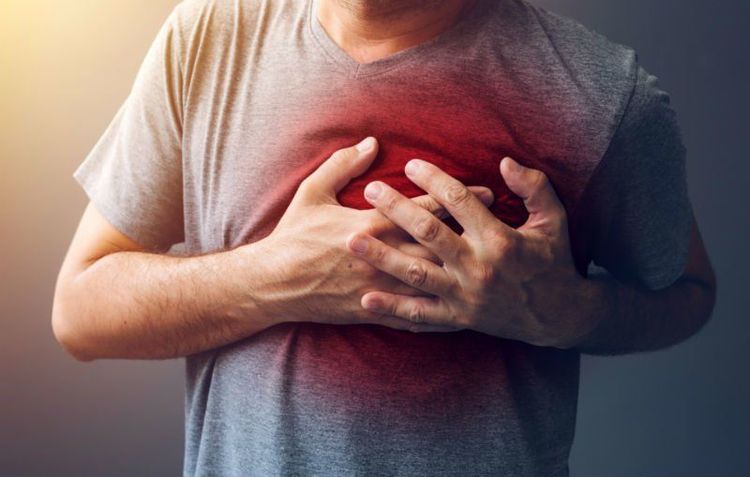
Cơn đau thắt ngực dữ dội là dấu hiệu cảnh báo điển hình của nhồi máu cơ tim cấp
3. Complications of myocardial infarction
Waking up after a heart attack is a blessing. But this is just the beginning, because the patient will continue to have to be treated and face the risk of sudden death within 3 weeks of the onset of the disease, because the heart rhythm is disordered, the heart is easily broken, the pulmonary embolism, cerebral embolism, pulmonary edema or cardiogenic shock. At the end of the above period, all dangers are gradually reduced, but the sequelae are still challenging the patient.Therefore, in the early stages, both patients and caregivers must be alert for unusual signs to promptly report to the doctor, avoiding all risks.
3.1 Early Complications Sudden Death: Up to 10% of heart attacks result in sudden death. Sudden death is the most severe complication that can occur in the first week after the onset of illness. Caused by ventricular fibrillation, ventricular tachycardia, ruptured heart, pulmonary embolism, acute vascular collapse.
Heart arrhythmia: 90% of patients have arrhythmia. When myocardial ischemia within 48 hours from the onset of the disease, it is easy to have this condition. If after 48 hours, it will be a matter of urgency if the heart rate is still so disturbed.
In this case, limiting stress, tension, and fear will help reduce the associated risks.
Heart failure: This sequelae is likely to occur at 2 weeks from the onset of the disease, easy in the case of recurrence of the disease, or the occurrence of angina in the previous chest area. Patients are at risk of cardiovascular collapse, with symptoms such as low blood pressure, weak pulse, rapid pulse, and sweating profusely.
If it is acute left heart failure, the patient will feel paroxysmal shortness of breath, rapid pulse rate, acute pulmonary edema...
Embolism causes accidents Blood clots cause myocardial infarction, if moved to other parts will cause blood vessel blockage, risk of stroke, pulmonary embolism...
Heart rupture Up to 10% of heart ruptures occur in the 2nd week after the onset of the disease. Often, the left ventricle causes blood to spill out of the pericardium, causing heart failure and death.
Ischemia to the myocardium: The rate of patients with secondary infarction again is up to 30%. The secondary manifestation is right angina pectoris and is treated like an acute infarction. This is a common complication in people with long-term diabetes.
3.2 Late complications Enlarged septum: Up to 30% of cases occur with heart failure or aortic occlusion.
Irregular ventricular rhythm: Need to put an EF blood pressure index less than 35% in case of irregular ventricular rhythm combined with aneurysm septum.
Shoulder - hand syndrome: Only appears from 6 to 8 weeks after the onset of the disease. Shoulder - hand syndrome is common in the left shoulder - left hand, causing pain in the shoulder and wrist, mainly caused by degenerative inflammation and fibrosis of the joint area. The sooner you try to exercise after a stroke, the less likely you are to experience these complications.
Nerve pain: Appears chest pain gradually spreading, moderate level accompanied by a feeling of heaviness, heaviness in the heart area. Common in people with stress, anxiety, physical and mental depression. Solved by psycho-sedative therapy and sedative drugs.
Heart failure: The function of the heart is markedly weakened after a myocardial infarction, gradually developing rapidly into dangerous heart failure.
Pericarditis syndrome: There are 3 - 4% of cases with symptoms of pain behind the sternum; severe pain when breathing, moving, coughing; Pain is relieved when sitting or bending forward.
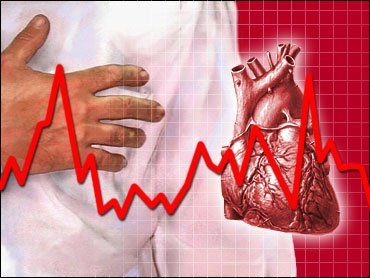
Suy tim là một trong những biến chứng nặng của nhồi máu cơ tim
4. How to treat a heart attack?
Is a heart attack curable? In fact, the treatment of the disease is instantaneous, if there is a reasonable lifestyle, the patient can still fight the sequelae that may be encountered later.Treatment methods for myocardial infarction include:
Emergency: Patients who see signs of angina in the chest must be taken to the emergency room immediately, emergency methods when having a heart attack include:
- Treatment oxygen therapy
- Conduct electrocardiogram
- Use Aspirin: this drug has the effect of thinning the blood, reducing the development of blood clots
- Using Glyceryl trinitrate: this drug is placed under the patient's tongue promote the effect of helping blood vessels to relax blood vessels, when the size of the diameter of blood vessels increases, blood can easily pass through the blocked site, causing the amount of blood returning to the heart to be reduced, and at the same time, blood pressure is also reduced. reduce
- Anti-pain: morphine is used to fight pain, help patients feel less afraid, heart rate is reduced.
- Complications to monitor: heart arrhythmia, blood pressure changes.
Coronary artery bypass: - Medical treatment: use drugs that dissolve blood clots, such as urokinase, streptokinase... During emergency, maintain anticoagulant therapy with Vasopolis or Aspirin. Use Vasopolis only if the patient is allergic to Aspirin or has stomach and duodenal disease
- Surgical treatment: inserting a catheter through the artery in the thigh into the coronary artery, angioplasty, breaking the blood Both clotting and atherosclerotic part, besides, it is possible to insert stents into the vessels
Cardiac transplant surgery - Coronary heart bypass surgery: The purpose is to resupply more blood to the heart when it is in crisis because of the arteries. congestion.
- The leg vein is cut and then connected to the aorta with the artery after the blockage.
Besides medical examination, screening and diagnosis of myocardial infarction, Vinmec International Hospital has many effective treatment methods for this disease, including fibrinolytic therapy for patients with myocardial infarction. blood in the acute phase.
This is an effective treatment in nearly all cases with a success rate of over 95%, performed by Vinmec's experienced cardiologist Dr. Luong Vo Quang Dang - Internal Medicine Doctor. Cardiologist, Head of Department of Medical Examination and Internal Medicine at Vinmec Phu Quoc International General Hospital.
Doctor Tran Quoc Tuan has 12 years of experience at Vinh Long General Hospital, Gia Dinh People's Hospital, Nguyen Trai Hospital. Currently working as an Emergency Resuscitation Doctor at Vinmec Phu Quoc International General Hospital.
Thrombolysis treatment technique is conducted with the support of modern imaging equipment, ensuring absolute safety for all patients.
Please dial HOTLINE for more information or register for an appointment HERE. Download MyVinmec app to make appointments faster and to manage your bookings easily.





